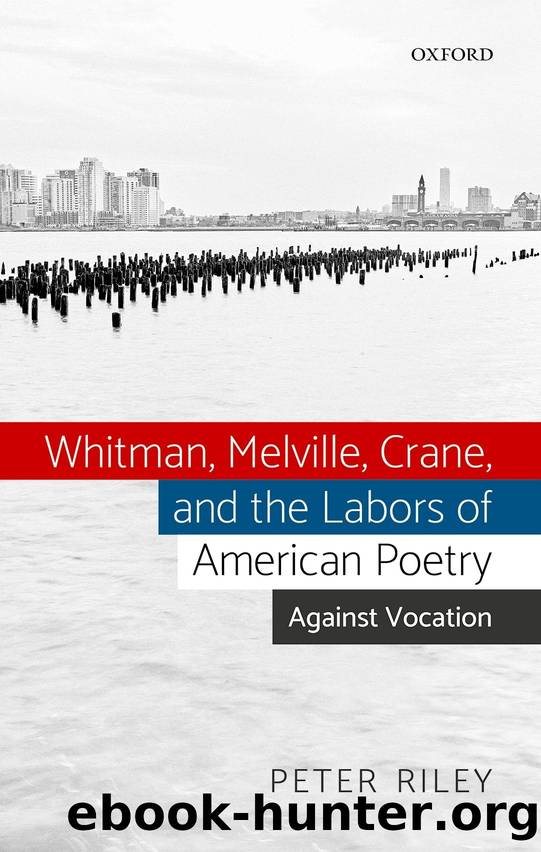Whitman, Melville, Crane, and the Labors of American Poetry by Riley Peter;

Author:Riley, Peter; [Riley, Peter]
Language: eng
Format: epub
Publisher: Oxford University Press USA - OSO
Published: 2019-05-06T00:00:00+00:00
The first line comprises four rising beats and sets the metrical precedent for the majority of poemâs lines, a synthesis of metrical and urban structures. The âchamber low,â an enclosed place, is also a play on the poetâs choice of form, which is accordingly âscored by timeâ: either the chamber is scratched and striated, or given a time signature of four beats per line. It is out of this urban and prosodic confinement that the verse begins materially sculpting its representation of the subjectâor the subjectedâwith Manhattanâs urban geography haunting various features of the Holy Land. The anastrophe âIn chamber lowâ elides âIn a low chamberâ so that the line can accommodate the first two rising beats of the four-beat pattern. The effect of this opening is one of compaction; the sentence begins âIn chamber lowâ and finishes six lines later with âA student sits, and broods alone.â The distance between the initial preposition âInâ and its immediate governance, the âMasonry old,â is relatively easy to follow, but then the semicolon at the end of line three forces the connotation of the preposition forward, so that it appears also to govern âthe studentâ: âIn chamber low and scored by time [ ⦠] A student sits and broods alone.â The function of âInâ is stretched to the end of the passage, and the reader, in search of grammatical resolution, compresses the intervening lines.
The chiastic movement of the passage produces an unmistakable brick-kiln compaction. Everything is ambiguously jammed in until the squeezed and disjointed subject becomes indistinguishable from his environment. Clarel begins with something complete, a âlow chamberâ; the second and third lines then dismember this totality into parts or qualities: it has lime-washed masonry, it resembles a tomb. The semicolon marking the mid-point of the six lines then quietly switches the referent, so that lines four and five now begin anatomizing the student: elbow on knee, brow sustained on sidelong hand. Line three, however, has introduced a metaphorâthe chamber is âmuch like a tombââso a confusion arises as to whether âElbow on knee and brow sustainedâ is an extension of this metaphor or something else. Does it refer to a sustaining beam that is holding up the brow of the tomb-like chamber? Or does it refer to a person? The passage lacks grammatical orientation: it is only when the fully formed student appears in the last line that we can definitely say: there is a student sitting in a room. The textâs subtle chiastic shift of âwhole, parts; parts, wholeâââorganized by the meterâcompresses and elides subject and object. The student, embedded in his linguistic and physical surroundings, emerges as a fossil in the walls.
The âwallsâ of the poem are metrically made up of sixteen strongly felt beats over the first four lines, and a rhyme scheme that sets up the expectation of a resolution (aab[b]): time/lime/stone/[?]. Melville invokes the pull of a 4Ã4 pattern, but then prevents its completion with âsustainedâ: the flow of the sentence is sustained, as its
Download
This site does not store any files on its server. We only index and link to content provided by other sites. Please contact the content providers to delete copyright contents if any and email us, we'll remove relevant links or contents immediately.
The Universe of Us by Lang Leav(14367)
The Sun and Her Flowers by Rupi Kaur(13694)
Adultolescence by Gabbie Hanna(8145)
Whiskey Words & a Shovel II by r.h. Sin(7480)
Love Her Wild by Atticus(7232)
Smoke & Mirrors by Michael Faudet(5508)
Wiseguy by Nicholas Pileggi(4586)
The Princess Saves Herself in This One by Amanda Lovelace(4509)
Love & Misadventure by Lang Leav(4355)
Milk and Honey by Rupi Kaur(4227)
Memories by Lang Leav(4171)
Good morning to Goodnight by Eleni Kaur(3806)
Bluets by Maggie Nelson(3709)
Too Much and Not the Mood by Durga Chew-Bose(3693)
Algedonic by r.h. Sin(3500)
Pillow Thoughts by Courtney Peppernell(3395)
The Poetry of Pablo Neruda by Pablo Neruda(3366)
HER II by Pierre Alex Jeanty(3170)
Stuff I've Been Feeling Lately by Alicia Cook(3053)
